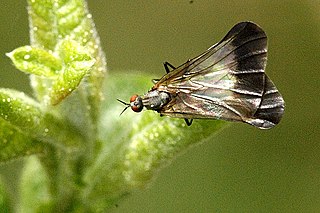
The Empidoidea are a large monophyletic superfamily of true flies, the sister taxon to the Muscomorpha (Cyclorrhapha). These two groups are sometimes united in the unranked taxon Eremoneura. There are some 10,000 known species within Empidoidea, which are represented on all continents except Antarctica. They are known to have existed since the Jurassic period.

Empididae is a family of flies with over 3,000 described species occurring worldwide in all the biogeographic realms but the majority are found in the Holarctic. They are mainly predatory flies like most of their relatives in the Empidoidea, and exhibit a wide range of forms but are generally small to medium-sized, non-metallic and rather bristly.

Hybotidae, the typical dance flies, are a family of true flies. They belong to the superfamily Empidoidea and were formerly included in the Empididae as a subfamily.

Dolichocephala is a genus of dagger flies in the family Empididae. There are at least 50 described species in Dolichocephala.

Empis livida is a species of dance fly, in the fly family Empididae. It is included in the subgenus Kritempis of the genus Empis. Males range from 7.5–9.3 millimetres (0.30–0.37 in), females 7.5–10.2 millimetres (0.30–0.40 in). The male's abdomen is brownish, and his wings appear faintly brown and clouded. The female's abdomen is gray and her wings are clear. E. livida lives in hedgerows, feeding on the nectar of several species of Rosaceae, several species of Asteraceae, and Heracleum sphondylium nectar; they also feed on other insects. They live all across temperate and Northern Europe, the only species with such a wide distribution. E. livida larvae are also carnivorous and live in damp soil and leaf litter. Adults fly in between April to July.

Empis is a genus of dance fly, in the fly family Empididae. It contains the following subgenera and species:

Rhamphomyia is a genus of dance flies, in the fly family Empididae.

Hemerodromiinae are a worldwide group of predatory flies with raptorial forelegs.

Empidinae are a subfamily of empidoid flies. They are mainly predatory flies like most of their relatives, and generally small to medium-sized. Most species are flower visitors and they can be effective pollinators.

Phyllodromia is a genus of dance flies. There are about 10 described species in Phyllodromia.

Ragadidae is a family of true flies in the superfamily Empidoidea. It was formerly considered a lower taxon, but was published as a new subfamily within Empididae in 2016. Since then, it has been classified as the sister group to Empididae, and has been elevated to family level based on the genetic differences which separate it from Empididae.
Wiedemannia is a genus of flies in the family Empididae.
Macrostomus is a genus of flies in the family Empididae.
Chelipodozus araucariana is a species of dance flies, in the fly family Empididae.
Chelipodozus australis is a species of dance flies, in the fly family Empididae.
Chelipodozus chelipodiformis is a species of dance flies, in the fly family Empididae.
Chelipodozus mapucheensis is a species of dance flies, in the fly family Empididae.
Chelipodozus luteothorax is a species of dance flies, in the fly family Empididae.
Chelipodozus cinereus is a species of dance flies, in the fly family Empididae.
Chelipodozus ochraceus is a species of dance flies, in the fly family Empididae.







